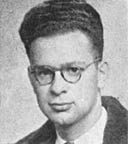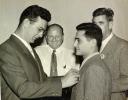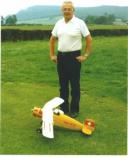
|
|
 |
John J. Makkinje 1931-2013 |
| 1931 | Date of birth: 8 December 1931 - Muiden, Netherlands |
| 1948 | In 1948 started to work for Philips (NSF) in Hilversum and followed a 3 year in-house course in radio maintenance and engineering. |
| 1951 | Military Service: Signal Corps 1951 - 1953. After completing the first six month "boot camp" was sent to the US Army Signal School at Fort Monmouth NJ. to follow a nine month microwave maintenance course. Upon returning to the Netherlands in October 1952 was involved in developing a maintenance course for fire control radar and IFF equipment. During the floods in January 1953 was in charge of one of the first mobile communications units to arrive in the disaster area and establish a microwave link between the emergency units that had been cut off from the rest of Holland. When the American Signal Corps arrived from Germany serious interference problems were encountered with the various armed forces units operating in the area. This led to an assignment as the Liaison (NC) Officer during the disaster relief operations in Zeeuws Vlaanderen Completed his army service in April 1953 Returned to work for Philips but could not quite get used to being home again. |
| 1953 |
In September 1953 was hired by Tapline as a Radio Technician and was assigned to Turaif pumpstation. Upon his arrival there was received by John J. Kelberer and John. L. Koenreich, two individuals who were to become not only very prominent Tapline and later Aramco executives but also his role models and life long friends. |
| 1956 |
In 1956 sustained torn ligaments of the left arm as a result of a automobile accident in Wadi Hafar and was sent to Beirut for medical evaluation. While in Beirut met Hanna Chedid , who at that time worked in Tapline Public Relations Department and who later became his wife. They were married in the American Community Church in Beirut on the 24th of December 1957. They have two sons, Anthony and Bernard who were both born in Beirut and now live in the United States. |
1960
|
Upon his transfer to Sidon the previous month, was promoted to Communications Supervisor which was followed in 1960 by promotion to Supervisor Communications, Electrical and Instrumentation. |
| 1966 |
In April 1966 was transferred to Turaif as Supervisor Communications, Saudi Arabia. This was a very busy period because it involved working at other stations to improve the reliability of the VHF communications links that carried besides 4 voice channels the essential surge protection signals between unattended Auxiliary Puming Units and the upstream main station. These signals were essential as the loss of this signal for any reason would reduce the preceeding stations discharge pressure to about half. There were already plans to increase the rated horsepower of the gasturbines as well as operating the pipeline at higher pressures of up to about 70 percent of yield so the dependability of the radio links became more important. |
| 1969 |
Was promoted to Superintendent Communications, Electrical and Instrumentation in August 1969. During this time the gas turbine control systems were extensively modified and improved to allow more dependable and safer unattended operation The Microwave Communications Program was started in 1972 which was to be completed in late 1973. This a.o. solved the reliability problem of the surge protection signals and it thus ceased to be a limiting factor in daily pipeline throughput. The next problem that restricted throughput was the excessive turbine down time caused by the high levels of sodium in the crude oil that was used as fuel for the gas turbines and severely reduced the operating life of the turbine combustion system. |
| 1972 |
In 1972 after a thorough reorganization followed a promotion to Superintendent Maintenance which covered all maintenance along the line. The problem of desintegrating foundations of the diesel prime movers was addressed and an extensive program of installing these engines on foundation rails was initiated. This was not a new concept but for reasons unknown, the practice had previously not been adopted. The problem of the sodium was never solved, the small fuel treatment units that were ordered for each APU and Turaif were ordered and shipped but were landed in Beirut Port when the civil war broke out and were practically destroyed. However the effect on throughput was somewhat minimised by increased speed at which the combustion systems change-outs were performed in situ. |
| 1977 |
In 1977 was promoted to General Superintendent with responsibility for all operations in Saudi Arabia. Crude deliveries to Lebanon had almost ceased in 1976 except for periodic deliveries to Medreco. Crude deliveries to Jordan were maintained. Manning levels were drastically reduced as was engineering support from Beirut. This however was a period where some long overdue maintenance problems could be addressed, such as replacing the deteriorated bottoms of the crude storage tanks. A company specialising in this work was called in to replace two tankbottoms. But then again, as happened so many times before, it was decided that this work could be done better and cheaper by Tapline crews. A machine was built from bits and pieces to cut a single pass slot into a section of the tank shell perfectly straight through which the new bottom plates could be inserted into the tank. This cut the cost and time by 25 percent. By this time the traffic along the pipeline road, which was still the main artery from Jordan, Syria and Europe to the Eastern province has increased to unprecedented levels as did the number of trucks that hit the pipeline. This caused considerable damage especially if it resulted in a fire, which was most of the time. |
| 1981 |
Was promoted to Manager of Operations in 1981 after having served in that capacity on an "acting" basis for 3 years. When Israeli forces occupied South Lebanon in June 1982 some mortar shells landed in the Sidon Tankfarm manifold area and ignited the escaping crude. The ensuing fire completely destroyed the manifold. This effectively stopped any oil movements within the Tankfarm or to the Medreco tanks. On 21 September 1983 was advised that the parent companies had decided to close the pipeline beyond Jordan permanently. At the same time was advised to get the crude oil, approx. 480.000 bbls. out of the line section between Km. 1035 and Sidon before the 31st of December. The job, which included getting a waterwell drilled at Km. 1035 to supply the water to move two scrapers was completed on the 26th of December 1983. |
| 1986 |
In February 1986 was instructed to draw up plans to close up Qaisumah. Rafha and Turaif pumpstations as well as Riyatain in Jordan. The go-ahead was given in April and the stations were closed by July. Only a small Plant protection force was left behind. All employees that were deemed necessary to maintain the installations were transferred to Badanah. While working on the close down plans and realising what would remain of Tapline, decided to opt for early retirement after completing the close down. He drove out of Turaif's main gate for the last time very early in the morning on the 1st of July 1986. The above Profile only lists some of the jobs I have been involved with. There were always many problems cropping up that needed a solution. This was especially true after the promotion to Superintendent Maintenance. The scope of this new position was very wide and I had very little experience in dealing with mechanical problems. However all those employees who could contribute something to widen my scope of understanding, did so without reservation. I received the same support from many people in Aramco whenever I asked for information or material assistance. |
 |
I am very much indebted to all of them. |
| John Makkinje's website with his travelogue along the line from 2001. | |

980628/bl - Last modified: Wed May 15 15:22:11 2013